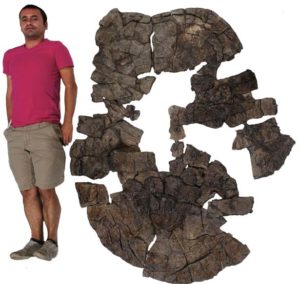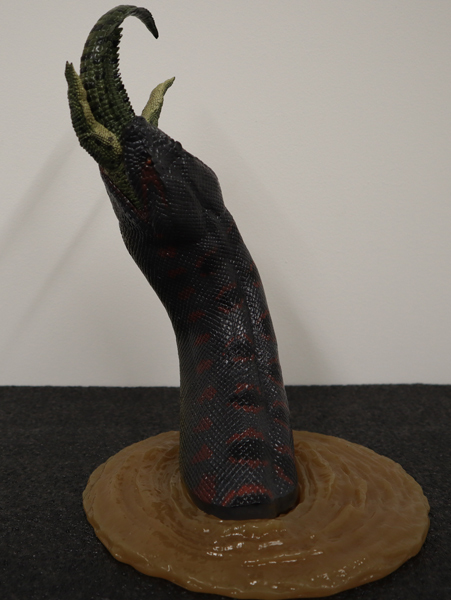Giant Freshwater Turtle Fossil from Colombian Coal Mine on (New Taxon is Described)
Giant Palaeogene Turtle – Predator of Crocodiles
Today, is World Turtle Day, a day to that is marked by a number of conservation organisations worldwide to increase our knowledge of, and respect for all things chelonian. These ancient creatures evolved before the dinosaurs and there are something like 250 species alive today. Most are threatened and vulnerable to extinction. One of the aims of World Turtle Day is to raise awareness about these reptiles and to highlight the ways in which mankind and our activity is affecting these creature’s and their chances of survival. In today’s blog post we discuss the discovery of a giant freshwater turtle fossil from a Columbian coal mine.
Chelonia are Parareptiles
Turtles are classed as Parareptiles, they are not closely related to the dinosaurs, or indeed marine reptiles such as ichthyosaurs and plesiosaurs. The shell, an armoured covering that protects the body of these creatures is a highly modified ribcage covered by armour plating. Palaeontologists believe that the first turtles and tortoises evolved around 220 million years ago (Triassic), a time when the dinosaurs themselves were evolving into a myriad of different forms.
The exact ancestry of the Chelonia is disputed, some scientists have postulated that they evolved from a group of Permian reptiles known as the pareiasaurs, these animals also possessed body armour and some pareiasaurs grew into giant forms like the car-sized Scutosaurus. It had been thought that the largest members of the Chelonia lived during the Cretaceous period, giant marine reptiles like the four-metre-long Archelon, but researchers and field workers exploring a remarkable Palaeogene-aged deposit have uncovered the fossilised remains of giant freshwater turtle – the largest freshwater member of the turtle family discovered so far.
Giant Freshwater Turtle
Scientists from North Carolina State University have been exploring a remarkable sixty-million-year-old, highly fossiliferous deposit in Colombia that has given palaeontologists a remarkable insight into a world recovering from the Cretaceous mass extinction event. The vertebrates that survived the events that saw the demise of the dinosaurs were able to slowly recover and to diversify. In a world with few large animals and in a very warm, global climate the reptiles once again began to thrive and the fossil record in a Colombian coal mine has revealed giant crocodiles, huge snakes and now the fossils of a freshwater turtle that was the size of a dining table.
After the Cretaceous extinction event, global temperatures soared and for many millions of years, certainly for the majority of the geological period known as the Palaeogene, these high temperatures led to the development of widespread, tropical rainforests. It has been estimated that the average global temperatures were around two times as high as they are today. Rainforests covered most of North and South America, Europe, Africa and Asia. Reptiles thrived in these conditions and the coal measures in the Colombian mine are providing scientists with evidence of some of the giant forms of reptiles that evolved to fill the ecological niches left by the extinction of the dinosaurs.
Carbonemys cofrinii
The new genus of giant freshwater turtle has been formally named Carbonemys cofrinii. The name means “coal turtle”. It belongs to a group of turtles that are still around today, although none of C. cofrinii’s modern counterparts are as big. Details of this new reptile discovery have just been published in the highly respected scientific publication “The Journal of Systematic Palaeontology”.
An Artist’s Impression of the Crocodile-eating Turtle

Picture credit: North Carolina State
Giant Freshwater Turtle
This giant, freshwater turtle has been classified as member of the Suborder Pleurodira, a group of turtles that pull their necks into their shells side-ways. Until this new discovery, another member of this Suborder, species known as Stupendemys geographicus was believed to be the largest freshwater turtle that ever existed. In fact, some scientists have estimated that based on the fossil evidence found so far, S. geographicus is larger than the Colombian fossil find.
Carbonemys cofrinii had a skull over ten inches long. The first fossil evidence of this creature was found at the coal mine site back in 2005, elements of the carapace was found in close proximity to the fossilised bones. The shell measures 172 centimetres in length, about the size of a family dining table.
All extant turtles and tortoises have a highly adaptable beak. Although modern forms eat a variety of foods – from plants to jellyfish, the palaeontologists have suggested that the strong beak of Carbonemys cofrinii indicate that this creature was a carnivore – capable of catching fish, crushing shellfish in its beak and even preying on crocodiles that shared its freshwater environment.
Studying the Columbian Deposits
The Colombian deposits have revealed a remarkable Palaeogene ecosystem that was dominated by giant reptiles. The apex predator may well have been Titanoboa – at over fifty feet in length the largest snake known in the fossil record. C. cofrinii may have evolved large size and a super strong shell to protect itself from attacks from other giant reptiles such as Titanoboa (Titanoboa cerrejonensis).
A Replica of the Giant Snake Titanoboa

Picture credit: Everything Dinosaur
The image above shows a Rebor Museum Class Titanoboa figure.
To view the Rebor range of models and figures: Rebor Prehistoric Animal Models.
To read more about the discovery of Titanoboa: Titanoboa – Huge Prehistoric Snake.
The fossils were first found by North Carolina PhD student Edwin Cadena who commented:
“We had recovered smaller turtle specimens from the site. But after spending about four days working on uncovering the shell, I realized that this particular turtle was the biggest anyone had found in this area for this time period – and it gave us the first evidence of gigantism in freshwater turtles.”
Turtles and tortoises co-existed with the dinosaurs for millions of years, but when the dinosaurs became extinct a whole range of new ecological niches were opened up and some of these niches were filled by the likes of Carbonemys cofrinii.
Scientists have put forward a number of explanations as to why giant reptiles evolved in this part of South America. Firstly, the environment was warm and wet, ideal for reptiles. There were few large predators, plenty of food and a relatively stable climate that permitted these giant genera to evolve and thrive.
So far, only one fossil specimen of this huge size has been discovered. Research Associate at the North Carolina Museum of Natural Sciences and the State’s palaeontologist Dr Dan Ksepka believes that this type of creature, an apex predator would have been relatively rare. Creatures this size would need a large territory to sustain them, even though their cold-blooded metabolism meant that they would not have needed to consume as much food as a warm-blooded mammal of similar size.
Dr Ksepka, co-author of the paper that describes this discovery, stated:
“It’s like having one big snapping turtle living in the middle of a lake. That turtle survives because it has eaten all of the major competitors for resources. We found many bite-marked shells at this site that show crocodilians preyed on side-necked turtles. None would have bothered an adult Carbonemys, though – in fact smaller crocodiles would have been easy prey for this behemoth.”
The Colombian coal mine may not be a viable source of fossil fuel any more but it is provided scientists with a remarkable insight into life on Earth shortly after the dinosaurs became extinct.
The scientific paper: “New pelomedusoid turtles from the late Palaeocene Cerrejón Formation of Colombia and their implications for phylogeny and body size evolution” by Edwin A. Cadena, Daniel T. Ksepka, Carlos A. Jaramillo and Jonathan I. Bloch published in the Journal of Systematic Palaeontology.
Visit Everything Dinosaur’s award-winning website: Everything Dinosaur.

